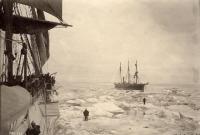In search of the lost Arctic: citizen-scientists recover 19th century sea-ice records from ship logbooks
Introduction
The Arctic is increasingly affected by a rapidly changing climate, but our ability to document, understand, and communicate about the past and future of the northern regions is hampered by limited environmental data. The additional data we need exists, thanks to the efforts of past generations of mariners, explorers, and scientists, but they are trapped in hundreds of thousands of pages of handwritten ship logbooks, field books, and weather journals. Once translated into digital format by Old Weather citizen-scientists and made available for new research this material will provide the best documentation of the past state of the Arctic marine environment that it is possible to assemble.
Why we did it?
The data being recovered by Old Weather citizen-scientists are used to drive sophisticated new retrospective analysis (reanalysis) systems at NOAA’s Earth Systems Research Laboratory and at other research centers around the world. These reanalysis systems generate the most detailed reconstruction of the Earth’s atmosphere of the past two centuries yet produced. The first-hand observations of sea ice will also give us a far more complete picture of what the Arctic ice pack was like before it began to disappear. As the available data resource is extended farther back in history it will be possible to investigate a range of lower-frequency climate phenomena that have been seen in the Arctic, to assess their impact on the regional environment, and to help validate climate and sea-ice models.
How we did it
Practical use of historical environmental data is constrained by a traditional limitation – the requirement for human skill to transcribe manuscript records into digital formats required by modern technologies like reanalysis systems. There are two key steps we have taken to overcome this limitation. The first was to establish joint ventures with the U.S. National Archives, the New Bedford Whaling Museum, the Providence Public Library, and other repositories that hold original logbooks and other observation-rich manuscripts, to obtain page-by-page digital images of these one-of-a-kind documents. The collaborative nature of the project allows us to digitally consolidate a corpus of material that is widely distributed across the country. Second, these images are posted to our Old Weather citizen-science project, where the handwritten records are being transcribed by many volunteers into digital text suitable for integration into global databases.
What we have discovered so far
We have now made digital photographs of the majority of the surviving U.S. ship logbooks relevant to the Arctic. These are in the process of being transcribed by Old Weather citizen-scientists, who have already produced several million new-to-science weather records. The data are flowing into global databases where they are being assimilated in reanalysis systems and sea-ice modeling experiments. Tests using the 20th Century Reanalysis show that the addition of new observations increases the accuracy of analyses and forecasts – the latter is noteworthy as this indicates improvement in the representation of the large-scale 3D circulation rather than only in the vicinity of the observations. Ongoing review of the raw sea ice data so far extracted from the logbooks is yet to reveal indications of a large sea-ice reduction in the Pacific Arctic comparable to the present.
What's Next?
On 3 December 2015 we are launching a new Old Weather project focused on Arctic whaling ship records. At the same time we are releasing a new and more powerful transcription interface that will make the enormous task of transcription more efficient.



